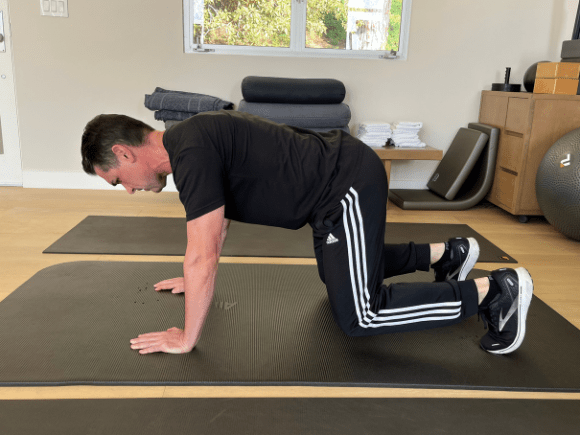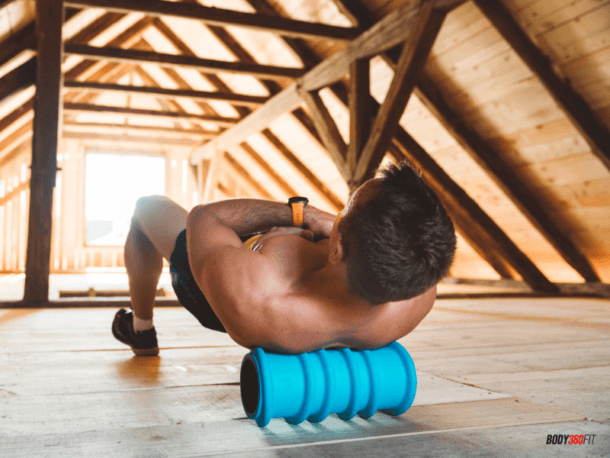Estimated reading time: 11 minutes
Unilateral Back Exercises
Ready to elevate your workout? These 7 unilateral back exercises will fix muscle imbalances, strengthen your back and core, and transform your routine!
But, before diving into the nitty-gritty of single-side back exercises, let’s glance at the list of Unilateral Back Exercises YOU NEED TO BE DOING for symmetry and strength.
- Side Plank Cable Row: This exercise targets your back muscles and engages your core for added stability. Avoid sagging hips and maintain a straight line from head to toe for optimal results.
- Front Plank Cable Row: Similar to the side plank cable row, this move amps the challenge by simultaneously targeting your front and side muscles. Keep your body in a straight line and avoid overarching your lower back.
- Elevated Front Plank Dumbbell Row: Elevate your game with this exercise! Performing a plank on an elevated surface and incorporating dumbbell rows will give your back and core an extra burn. Remember to keep your hips level and avoid shrugging your shoulders.
- Bent Over Unilateral KB Row: Grab a kettlebell and prepare to row! This exercise targets your back muscles while engaging your lower body for stability. Keep your back flat and avoid shrugging your shoulders upwards.
- ISO Lunge Unilateral KB Row: Combine lunges with kettlebell rows for a killer workout! Maintain a stable lunge position while rowing the kettlebell, ensuring proper form to maximize results.
- ISO Lunge Unilateral Cable Row: Switch things up using a cable machine for this exercise. Keep tension on the cable throughout the movement, and avoid letting your knee collapse inward during the lunge.
- Single Arm TRX Row: Grab onto the TRX straps and prepare to feel the burn! This exercise targets your back muscles while also challenging your stability. Focus on retracting your blades together and avoid swinging your body.
Table of contents
- Unilateral Back Exercises
- Key Takeaways
- What are Unilateral Back Exercises?
- What Muscles Do Unilateral Back Exercises Work?
- Five Benefits of Unilateral Back Exercises
- What’s the Difference Between Unilateral and Bilateral Training?
- 7 Best Unilateral Back Exercises: Description, Benefits, How to Perform With Good Form
- Final Summary
Key Takeaways
- Unlock Balanced Power: This guide reveals the 7 best unilateral back exercises to correct muscle imbalances and improve strength gains.
- Beyond Bilateral: Dive into the key differences between unilateral and bilateral training and see how unilateral exercises offer distinct advantages.
- Muscles in Focus: Discover the specific back muscles each exercise activates, allowing you to tailor your workouts for maximum impact.
- 5 Reasons to Go Unilateral: Learn the hidden benefits of unilateral training, from improved form to injury prevention, and understand why this type of exercise is a must-have in your upper body workout routine.
What are Unilateral Back Exercises?
Picture this: instead of using both arms (bilateral movements) to strengthen your back, unilateral movements focus on working one side of your back at a time. These moves are a great way to address and ensure that the weaker side of your back gets just as much attention as the dominant side of the body.
What Muscles Do Unilateral Back Exercises Work?
Now, let’s talk back, muscles! Unilateral back exercises primarily target the latissimus dorsi, rhomboids, and trapezius muscles. However, these exercises are not just limited to primary muscle groups, but also include stabilizing muscle groups as well. This is one of the reasons I prefer this type of functional strength training for all of my clients.
Five Benefits of Unilateral Back Exercises
Here are five fantastic benefits that unilateral back exercises bring to the table:
1. Improve Muscle Asymmetries and Imbalances: Say goodbye to uneven strength levels! Unilateral exercises help balance out discrepancies between your dominant and weaker sides.
2. Boost Core Strength: A strong core is your body’s best friend, both in and out of the gym. Unilateral back exercises engage your core muscles, helping you develop a rock-solid midsection.
3. Injury Prevention: Nobody wants to be sidelined with an injury. Unilateral exercises strengthen your muscles and enhance stability, reducing the risk of workout-related mishaps.
4. Enhance Grip Strength: A firm grip isn’t just for handshakes; it’s essential for lifting heavy weights and dominating daily life tasks. Unilateral exercises give your grip strength a severe boost, making you the reigning champ of any challenge that comes your way.
5. Improve Motor Skills: Like a finely tuned machine, unilateral back exercises improve your body’s coordination and control, ensuring smooth and precise movements in every workout.
What’s the Difference Between Unilateral and Bilateral Training?
In the world of functional exercise, both unilateral and bilateral exercises have their place, each offering unique benefits and drawbacks. Here’s a comparison to help you choose the right type for your goals:
Unilateral Exercise Training:
Pros:
- Improved balance and stability: Working each side of your body independently challenges your core and stabilizer muscles, leading to better overall muscular balance in strength and stability of your joints.
- Reduced risk of injury: By addressing imbalances between sides, unilateral training can help prevent injuries caused by uneven strength or development.
- Enhanced neuromuscular coordination: Each limb works independently, demanding greater focus and coordination, which can transfer to improved athletic performance.
- More significant functional carryover: Many daily activities and sports involve unilateral movements (walking, running, jumping, kicking), so unilateral training translates well to real-life situations.
- Rehabilitation benefits: Unilateral exercises often focus on strengthening a specific limb after injury or surgery.
Cons:
- Lower weight load: You can typically lift less weight with unilateral exercises compared to bilateral ones, limiting strength gains.
- Greater technical demand: Proper form is crucial for unilateral exercises, making them more challenging to master than some bilateral counterparts.
- Longer training time: Performing exercises for each leg individually can take more time than bilateral exercises.
Bilateral Exercise Training:
Pros:
- More significant strength gains: Lifting heavier weights with both limbs simultaneously allows for quicker overall strength and power increases.
- More straightforward technique: Many bilateral exercises are more accessible to learn and perform correctly, making them suitable for beginners.
- More time-efficient: Completing exercises for both limbs together saves time compared to unilateral training.
- Increased metabolic demand: Lifting heavier weights can engage more muscle mass and boost your metabolism.
Cons:
- Limited balance and stability improvement: Bilateral exercises challenge your balance and stability less than unilateral ones.
- Potential for muscle imbalances: Neglecting unilateral training can lead to imbalances between your dominant and non-dominant sides, increasing injury risk.
- Lower functional carryover: Bilateral exercises may translate less well to real-life activities or sports that involve unilateral movements.
The Verdict:
While unilateral back exercises take center stage in this article, achieving balanced back strength ultimately requires both unilateral and bilateral movements. To help you strike the right balance, here are some general guidelines:
- Balance: Aim for a balanced mix of both types of exercises throughout your training week.
- Goals: If your primary goal is strength development, prioritize bilateral exercises. If you focus on improving balance, stability, or functional movement, emphasize unilateral exercises.
- Injury prevention: Include unilateral exercises to address muscle imbalances and reduce injury risk.
- Individual needs: Consider your experience level, fitness goals, and any limitations when choosing exercises.
Remember, consulting a qualified coach or trainer can help you design a personalized training program incorporating unilateral and bilateral exercises to safely and effectively achieve your specific goals.
7 Best Unilateral Back Exercises: Description, Benefits, How to Perform With Good Form
Here’s a breakdown of great unilateral exercises, including their descriptions, benefits, muscles worked, equipment needed, tips, and proper form instructions:
1. Side Plank Cable Row
Description: You’ll perform a cable row while holding a side plank position, targeting your lats, obliques, and core.
Benefits: Improves core stability, strengthens lats and obliques unilaterally, and challenges balance.
Muscles worked: Lats, obliques, core.
Equipment: Cable machine, handle attachment.
Tips:
- Engage your core throughout to maintain the plank position.
- Keep your hips square to the ground, avoiding twisting your torso.
- Control the weight on both the pull and lower phases.
Instructions:
- Set up a cable machine with a pulley in the lowest position.
- Assume a side plank in either a long lever (legs straight or a short lever (knees bent) with your hand gripping the handle.
- Row the weight towards your hip, squeezing your lat.
- Slowly return to the starting position.
- Repeat on the other side.
2. Front Plank Cable Row
Description: Similar to the side plank row, but performed in a front plank position, targeting your lats, core, and shoulders.
Benefits: Strengthens lats and core, improves shoulder stability, and challenges core control.
Muscles worked: Lats, core, shoulders.
Equipment: Cable machine, handle attachment.
Tips:
- Maintain a straight line from head to heels throughout the exercise.
- Avoid lag in your lower back and hips. Keep from arching your back.
- Keep your shoulder blade pulled down and back during the row.
Instructions:
- Set up a cable machine with the pulley in the lowest position.
- Assume a front plank position with your hand gripping the handle.
- Pull the weight towards your hip, squeezing your lat.
- Slowly return to the starting position.
- Repeat on the other side.
Watch this video on YouTube
3. Elevated Front Plank Dumbbell Row
Description: Performed in a front plank position with one hand on a raised platform, targeting your lats, core, and shoulders with a stability challenge.
Benefits: Offers a dynamic challenge for core stability, strengthens lats and shoulders unilaterally, and improves balance.
Muscles worked: Lats, core, shoulders.
Equipment: Dumbbell, platform (bench, box, etc.).
Tips:
- Keep your body in a straight line, hips, and shoulders level.
- Engage your core to maintain stability on the platform.
- Control the weight during both phases of the movement.
Instructions:
- Place one arm on a platform and assume a front plank with the other arm extended to the floor.
- Hold a dumbbell in the free hand.
- Row the dumbbell towards your hip, squeezing your lat.
- Slowly return to the starting position.
- Repeat on the other side.
Watch this video on YouTube
4. Bent Over Unilateral KB Row
Description: A hinge-based row with a kettlebell targeting your lats, rhomboids, and core.
Benefits: Strengthens posterior chain muscles, improves grip strength, and challenges core stability.
Muscles worked: Lats, rhomboids, core, hamstrings, glutes.
Equipment: Kettlebell.
Tips:
- Maintain a flat back throughout the movement.
- Keep your core engaged and hips stable.
- Use your lat muscle to pull the kettlebell, not your arm.
Instructions:
- Hinge at the hips, keeping your core engaged and back flat.
- Hold a kettlebell in the other hand with your arm straight down.
- Row the kettlebell towards your hip, squeezing your lat.
- Slowly lower the kettlebell back down.
- Repeat on the other side.
Watch this video on YouTube
5. ISO Lunge Unilateral KB Row
Description: A row performed in a static lunge position with a kettlebell, targeting your lats, core, and legs.
Benefits: Improves unilateral strength and coordination, challenges core stability, and simultaneously works for multiple muscle groups.
Muscles worked: Lats, core, hamstrings, quads, glutes.
Equipment: Kettlebell.
Tips:
- Maintain a perfect split squat position. Your front knee should be at a 90-degree angle, while your back knee should be about 2″ above the floor.
- Maintain a tall spine and engaged core.
- Row the kettlebell towards your hip, squeezing your lat.
Instructions:
- Step forward into a lunge position, holding a kettlebell in one hand.
- Place your opposite forearm (non-rowing side) across your bent knee.
- Keep your back straight, core engaged, and front knee bent at a 90-degree angle.
- Row the kettlebell towards your hip, squeezing your lat.
- Slowly lower the kettlebell and repeat.
Watch this video on YouTube
6. ISO Lunge Unilateral Cable Row
Description: Similar to the ISO lunge KB row, but using a cable machine for added control and resistance.
Benefits: Offers progressive overload with adjustable cable weight, challenges unilateral strength and coordination, and improves core stability.
Muscles worked: Lats, core, hamstrings, quads, glutes.
Equipment: Cable machine, handle attachment.
Tips:
- Maintain proper lunge form with a 90-degree bend in your front knee.
- Engage your core throughout the movement.
- Control the cable weight on both the pull and lower phases.
Instructions:
- Set up a cable machine with the pulley in the lowest position.
- Step forward into a lunge position, facing the machine.
- Grasp the handle with the hand on the same side as your front leg.
- Elevate your body so your knee is hovering 2″ above the floor.
- Row the weight towards your hip, squeezing your lat.
- Slowly lower the handle back down.
- Repeat on the other side.
Watch this video on YouTube
7. Unilateral TRX Row
Description: Rowing your bodyweight using a TRX suspension trainer, targeting your lats, core, and upper back.
Benefits: Improves core stability, unilaterally strengthens lats and upper back muscles, and challenges balance and coordination.
Muscles worked: Lats, core, upper back, shoulders.
Equipment: TRX suspension trainer.
Tips:
- Maintain a straight line from head to heels throughout the movement.
- Engage your core to control your body position.
- Pull your shoulder blade down and back during the row.
Instructions:
- Adjust the TRX anchor point for your desired difficulty level.
- Lean back into the TRX, holding the handles with one hand.
- Row your body towards the handles, squeezing your lat.
- Slowly lower your body back down.
- Repeat on the other side.
Watch this video on YouTube
Remember, these are general descriptions and instructions. Adapting the exercises to your fitness level and consulting a professional for personalized guidance is crucial, especially if you have any injuries or limitations.
Final Summary
In conclusion, unilateral back exercises are a fantastic way to address muscle imbalances, improve core strength, prevent injuries, enhance grip strength, and refine motor skills. By incorporating these exercises into your routine, you’ll sculpt a strong and symmetrical back and boost your overall fitness levels. So, what are you waiting for? It’s time to unleash the power of these unilateral back exercises and take your workout game to the next level!
Until next time,
Christian Graham—NSCA-CPT, CFSC2, FMS2, KB, VIPR
Functional Strength & Mobility Specialist – @Body360Fit
PS. And remember, you’re just one workout away…
PPS. Did you enjoy reading this article about Unilateral Back Training? If so, please share it with your friends on Twitter, Facebook and Pinterest.
If you have have any questions regarding how to properly train your back or weight training in general, please ask in the comments below. You can also send me a message via the contact form. I’d love to hear from you!
Additional Learning
Latest Posts
- Ditch the Barbell: 15 Killer Barbell Front Squat Alternatives (with Videos!)
- 7 Unilateral Back Exercises You NEED to Be Doing (For Symmetry & Strength)
- Vega vs. Orgain Protein Powder: A Head-to-Head Comparison
- Indulge Your Cravings: Healthy Cookies and Cream Protein Powder Recipe
- Tribulus Terretris Spotlight: Unveiling the Top 11 Tribulus Supplements with Expert Insights










![Full Body Kettlebell Workout [PDF] | Body360 Fit](https://body360fit.com/wp-content/uploads/2021/01/Full-Body-Kettlebell-Workout-PDF.png)







